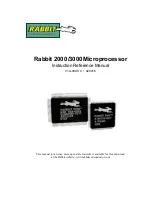
4
4-13
EIT
32180 Group User’s Manual (Rev.1.0)
4.8 Exception Processing
Figure 4.8.2 Example of a Return Address for Address Exception (AE)
(4) Branching to the EIT vector entry
The CPU branches to the address H’0000 0030 in the user space. This is the last operation performed in
hardware preprocessing.
(5) Jumping from the EIT vector entry to the user-created handler
The CPU executes the BRA instruction written by the user at the address H’0000 0030 of the EIT vector
entry to jump to the start address of the user-created handler. At the beginning of the user-created EIT
handler, first save the BPC and PSW registers and the necessary general-purpose registers to the stack.
Also, save the accumulator and FPSR register as necessary.
(6) Returning from the EIT handler
At the end of the EIT handler, restore the saved registers from the stack and execute the RTE instruction.
When the RTE instruction is executed, hardware postprocessing is automatically performed. At this time,
the CPU restarts from a word-boundary instruction including the instruction that generated an AE (see Figure
4.8.2). Except when using address exceptions intentionally, occurrence of an address exception suggests
that the system has some fatal fault already existing in it. In such a case, therefore, do not return from the
address exception handler to the program that was being executed when the exception occurred.
4.8.3 Floating-Point Exception (FPE)
[Occurrence Conditions]
Floating-Point Exception (FPE) occurs when Unimplemented Exception (UIPL) or one of the five exceptions
specified in IEEE 754 standards (OVF, UDF, IXCT, DIV0 or IVLD) is detected.
Note, however, that the EIT processing described below is executed only when the exception that occurred
is one whose exception enable bit in the FPSR register is set to "1" or an unimplemented exception.
[EIT Processing]
(1) Saving SM, IE and C bits
The PSW register’s SM, IE and C bits are saved to the respective backup bits: BSM, BIE and BC.
BSM
←
SM
BIE
←
IE
BC
←
C
(2) Updating SM, IE and C bits
The PSW register’s SM, IE and C bits are updated as shown below.
SM
←
Unchanged
IE
←
0
C
←
0
H ' 0 0
Address
AE occurred
H ' 0 4
H ' 0 8
H ' 0 C
+0
+1
+2
+3
H ' 0 0
Address
AE occurred
H ' 0 4
H ' 0 8
H ' 0 C
+0
+1
+2
+3
BPC
H ' 0 6
BPC
H ' 0 4
Return
address
Return
address
Summary of Contents for M32R/ECU Series
Page 17: ...12 This page is blank for reasons of layout...
Page 712: ...CHAPTER 18 OSCILLATOR CIRCUIT 18 1 Oscillator Circuit 18 2 Clock Generator Circuit...
Page 794: ...CHAPTER 22 TYPICAL CHARACTERISTICS...
Page 796: ...APPENDIX 1 MECHANICAL SPECIFICAITONS Appendix 1 1 Dimensional Outline Drawing...
Page 798: ...APPENDIX 2 INSTRUCTION PROCESSING TIME Appendix 2 1 32180 Instruction Processing Time...
Page 802: ...APPENDIX 3 PROCESSING OF UNUSED PINS Appendix 3 1 Example Processing of Unused Pins...















































